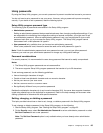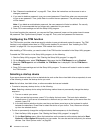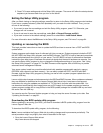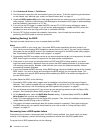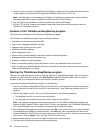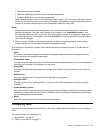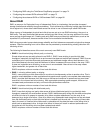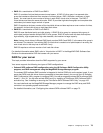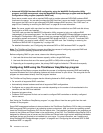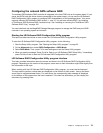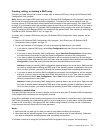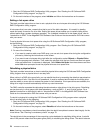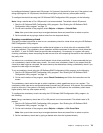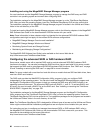
• RAID 10: a combination of RAID 0 and RAID 1
RAID 10 consists of striped data across mirrored spans. A RAID 10 drive group is a spanned drive
group that creates a striped set from a series of mirrored drives. RAID 10 allows a maximum of eight
spans. You must use an even number of drives in each RAID virtual drive in the span. The RAID 1
virtual drives must have the same stripe size. RAID 10 provides high data throughput and complete data
redundancy but uses a larger number of spans.
RAID 10 requires a minimum number of four hard disk drives and also requires an even number of drives,
for example, six hard disk drives or eight hard disk drives.
• RAID 50: a combination of RAID 0 and RAID 5
RAID 50 uses distributed parity and disk striping. A RAID 50 drive group is a spanned drive group in
which data is striped across multiple RAID 5 drive groups. RAID 50 works best with data that requires
high reliability, high request rates, high data transfers, and medium-to-large capacity.
Note: Having virtual drives of different RAID levels, such as RAID 0 and RAID 5, in the same drive group is
not allowed. For example, if an existing RAID 5 virtual drive is created out of partial space in an array, the
next virtual drive in the array has to be RAID 5 only.
RAID 50 requires a minimum number of six hard disk drives.
For detailed information about RAID, refer to “Introduction to RAID” in the MegaRAID SAS Software User
Guide on the documentation DVD that comes with your server.
RAID for your server
This topic provides information about the RAID supported by your server.
Your server supports the following two types of RAID congurations:
• Onboard SATA software RAID conguration using the LSI Software RAID Conguration Utility
program; and RAID management using the MegaRAID Storage Manager program
The onboard SATA software RAID controller is integrated in the Intel C202 chip on the system board. If your
server has SATA hard disk drives that are connected to the system board, you can use the LSI Software
RAID Conguration Utility program to congure RAID. Your server supports onboard SATA software RAID
levels 0, 1, and 10. You can also activate RAID level 5 by installing a ThinkServer SATA Software RAID 5
activation key. See “Installing or removing the ThinkServer SATA Software RAID 5 Key” on page 102
.
You can install and use the MegaRAID Storage Manager program to manage the RAID array and RAID
controller in an operating system environment.
For detailed information, see “Conguring the onboard SATA software RAID” on page 75
.
Chapter 5. Conguring the server 73



